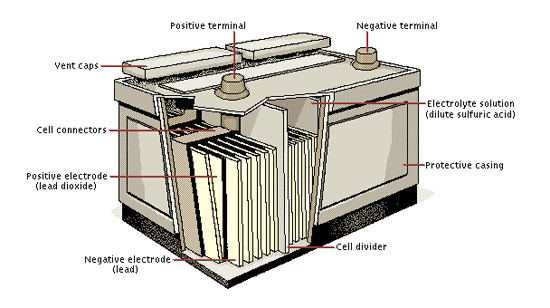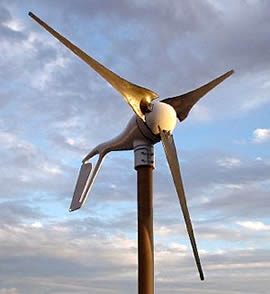There are a lot of electrical system questions on the various forums and messages boards. I certainly do not have any new information but I thought perhaps stating what I know might help some folks. I’ve certainly listened to two people say the same thing and only understood one them. Let’s limit our discussion to 12 volt (VDC) electrical systems of the “average” 26′-50′ boat.
The electrical system of a sailboat is not complicated nor much different than a car or general aviation aircraft. In all cases, a storage device exists – this is the battery. Something to create electricity and charge (“fill”) the battery – this is the alternator, solar panel, and/or wind turbine. Finally there are things that consume electricity – radios, pumps, fans, lights, inverters, etc… The primary difference with a sailboat is that there may be several charging devices all producing power at the same time.
A reasonably accurate volt meter should be required equipment. This does not need to be an expensive meter, just one that has been tested accurate.
Battery
 A typical 12 volt DC battery consists of six 2.1 volt cells. This makes for a total voltage of 12.6 volts for a brand new battery in perfect condition at full charge at 70 degrees (F.). This voltage level will decrease for a battery in a lesser condition. Thus; 12.6 volts should not be expected. As electrical energy is used from the battery, the voltage drops. A common misconception is that a 12 volt battery that is “half full” will read 6 volts. This is incorrect. A 12 volt battery is essentially “empty” at 11 volts. Many electrical components will not run on this low of voltage. A 12 volt battery that is “half full” will read about 12.0 volts. It is important to note that 50% charge is considered the lowest level to which a battery should be discharged. Below this level, the life of the battery is reduced at an inordinate rate.
A typical 12 volt DC battery consists of six 2.1 volt cells. This makes for a total voltage of 12.6 volts for a brand new battery in perfect condition at full charge at 70 degrees (F.). This voltage level will decrease for a battery in a lesser condition. Thus; 12.6 volts should not be expected. As electrical energy is used from the battery, the voltage drops. A common misconception is that a 12 volt battery that is “half full” will read 6 volts. This is incorrect. A 12 volt battery is essentially “empty” at 11 volts. Many electrical components will not run on this low of voltage. A 12 volt battery that is “half full” will read about 12.0 volts. It is important to note that 50% charge is considered the lowest level to which a battery should be discharged. Below this level, the life of the battery is reduced at an inordinate rate.
Charge Devices
An engine driven generator or alternator, solar panel, and wind turbine all do basically the same thing. They produce electrical current with a voltage that is sufficient to charge the battery. Obviously, the benefit of solar photovoltaic panels and wind turbines (windmill) is that the electricity is basically free (after the initial purchase price).
Battery Charging
All 12 volt batteries require a voltage higher than 12 volts to charge. Ideally, this voltage is somewhere between 13.8 and 14.4 volts. However; nothing is that simple. Depending on the type of battery in use, it probably has several “ideal” charge voltages that depend on the state of the battery. A “more empty” battery can accept a greater voltage level to more quickly “fill” the battery – often called bulk and/or boost charging. A battery that is “mostly full” and only needs “topped off” will prefer a lower voltage – often called normal or absorption charging.
Charge Controller
It is possible to operate most of the charge devices without a regulator or charge controller. However; that is pretty crude and a good way to destroy your battery. The most advanced of these are the MPPT charge controllers (Maximum Power Point Tracking) and, depending on your situation, are probably the best option. They are able to adjust the voltage output of the charge device so that the battery is charged in the most ideal way.
Engine Driven Alternator
Most boat engines have a simple alternator with a regulator that is set to 13.8 and 14.4 volts. When you fire up the engine, the alternator begins producing current and the battery is charged. The regulator has no intelligence – it just regulates the voltage to the set level.
Common Questions
With all of the above in mind, some common questions arise:
- My electrical system voltage with the engine running is 12.6 volts or less (engine driven alternator, no solar/wind). This means that the alternator is not producing electricity. There are a number of possibilities that require specific detail to troubleshoot. The point that I want to make is that this is battery voltage and if the alternator/regulator were working, the voltage would be higher (in the 13.5-14.4 range).
- I measure 12.4 volts at the battery but 12.2 volts at some other point in the system. All electrical wiring suffers from “voltage drop.” The amount of the lost voltage depends on the type, size, and length of the wire and the amount of current flowing. For example; a 30′ long 18 gauge copper wire with 5 amps flowing thru it at can be expected to lose approximately 2 volts. To decrease the loss, a larger wire size is required. The same scenario with a 12 gauge wire would result in a drop of only half a volt.
- I measure 13.8 volts at the battery with the engine running but only 12 volts at some point very near the battery. This is almost guaranteed to be a connection problem. A gas tight connection without any corrosion is necessary for electrical current to flow “smoothly”. Check all fittings and connections to be sure they are clean and tight.
Resources
There are a bunch of online guides and calculators that can help with all the above (and provide specifics). A few of them follow:
http://www.supercircuits.com/resources/tools/voltageDrop
http://www.windsun.com/ChargeControls/ChargeCont.htm
http://www.windsun.com/ChargeControls/MPPT.htm
http://www.morningstarcorp.com/en/support/library/8.%20Why%20PWM1.pdf


Leave a Reply